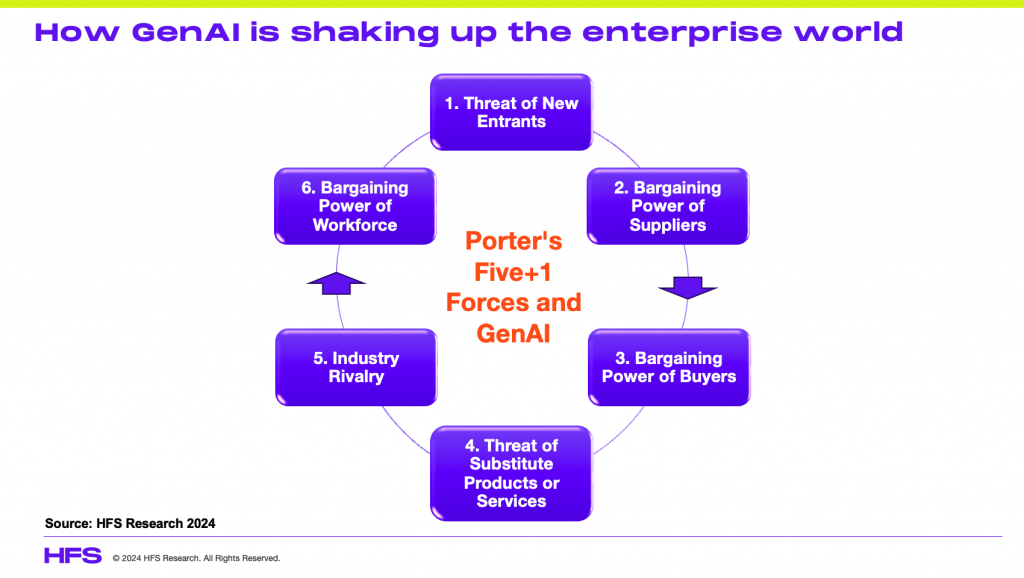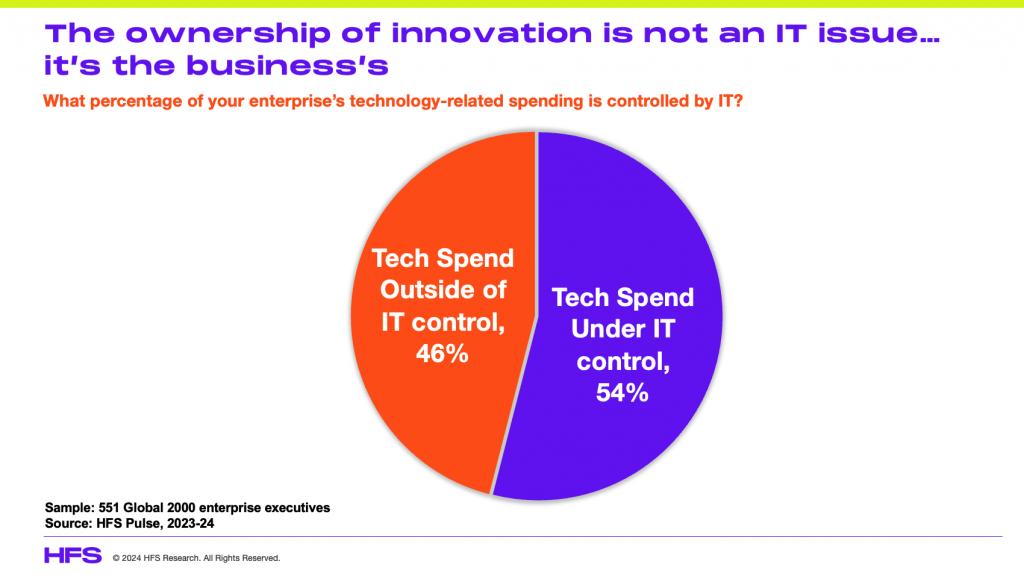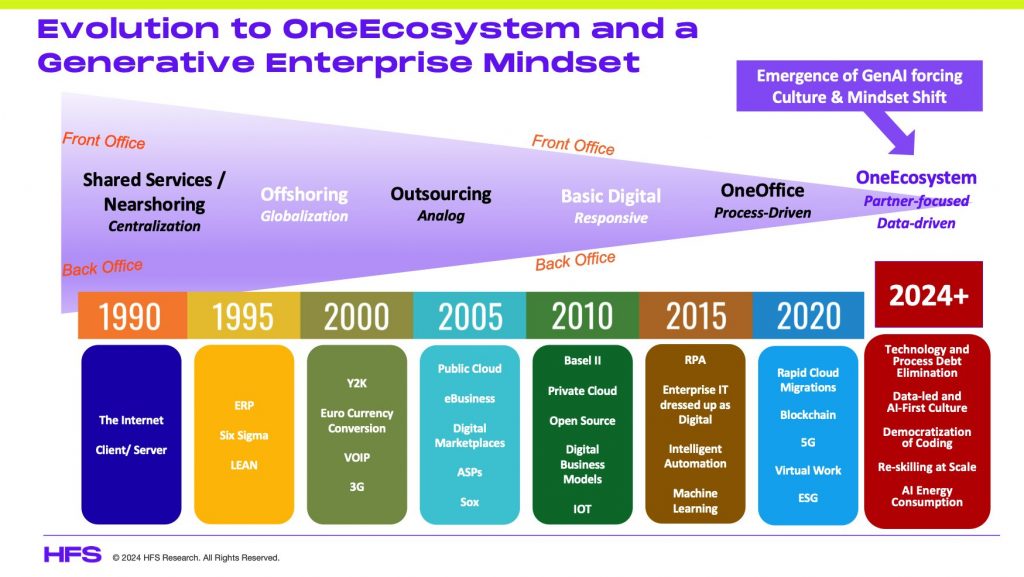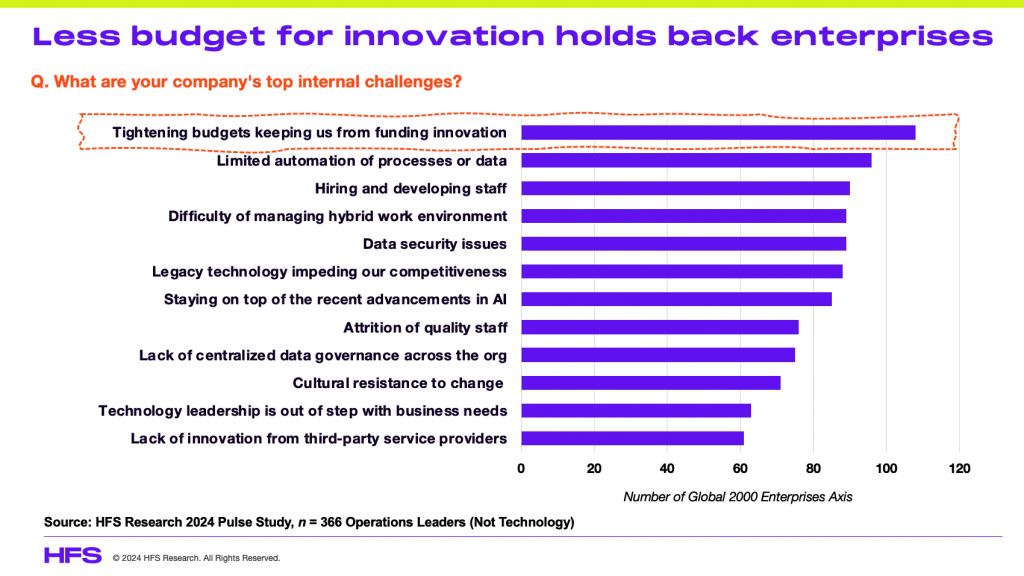We’ve finally reached the point in our careers when we need to learn new and more ingenious ways of doing things. No more papering over the cracks, no more passing the problems onto someone else to fix. WE are the problem that now needs fixing.
For decades, we’ve been throwing trillions at our enterprise operations, namely ERP systems, data warehouses, RPA, software engineers, process architects, etc. But to what end? To eke out some more efficiency here, rinse out some cost there? Move some data around a bit faster? Are these solutions still relevant by the time you’re done? Or is there always a new, shinier option capturing everyone’s attention?
It’s time to reinvent our whole mindset toward enterprise operations to save ourselves from drowning in our legacy pools of technology, process, data, skills, and culture.
Yes, we’ve been predicting the extinction of the corporate dinosaur for a while now, but we’re truly arriving at the time when tired old businesses will be displaced if they persist on limping along under the sheer weight of valueless technology and transactional people, determined to cling on to the “way we’ve always done things.” Your firm will sink under its ability to change anything, it’ll become increasingly uncompetitive, and you will go down with it groping for air, wondering why you suddenly lost your corporate relevance.
GenAI is the closest we’ve come to bridging the business/IT chasm
Eighteen months into the most significant technology rush since the ERP heydays, GenAI has the potential to change the game entirely because this is the first time business leaders can think like application developers to create new content, to access critical data, to command better ways to get things done, and so on.
Its ability to analyze unstructured data, create content, and qualitatively analyze and make recommendations is striking. The pace of model evolution and compute power is quickly advancing the technology to the point we are beginning to believe that GenAI-enabled middleware and frontend solutions may replace existing business process applications.
The big question now is whether business owners who clearly own innovation can reinvent how their companies operate or whether they are too burdened by three decades of technology, process, data, and culture debts.
Generative AI is your secret weapon. It tears down barriers, fuels innovation, and keeps you ahead of the curve. Adapt or perish – the choice is yours.
Using Michael Porter’s Five Forces (+1) framework, let’s break down how generative AI (GenAI) is shaking up the enterprise world:

- Threat of New Entrants: Smashing Entry Barriers. GenAI lowers technical and operational barriers for new entrants. OpenAI’s APIs, for example, enable startups to integrate powerful AI without heavy R&D costs, allowing them to compete with established giants. Brace yourself for an influx of AI-driven competitors, like how Grammarly leverages advanced AI to disrupt traditional proofreading and writing tools.
- Bargaining Power of Suppliers: Breaking Supply Chains. AI’s predictive and analytical powers disrupts traditional supply chains by eliminating middlemen. Farmers Business Network (FBN) uses AI to provide farmers with data-driven insights, price transparency, and predictive analytics, enabling direct and cost-effective purchasing from suppliers. This leads to significant cost savings, increased efficiency, and greater empowerment for farmers.
- Bargaining Power of Buyers. Mass Personalization of Customer Experience. Mars drives mass personalization in its pet food business using generative AI by analyzing data on pet health, preferences, and behaviors to create tailored nutrition plans. Through platforms like Kinship, Mars offers customized pet food recommendations, enhancing customer satisfaction and loyalty.
- Threat of Substitute Products or Services. This is where disruptive innovation comes into play. Adobe’s AI-powered tools, like Adobe Sensei, allow users to create stunning visuals and designs effortlessly, outpacing traditional design methods.
- Industry Rivalry: Productivity on steroids. With AI-driven automation, efficiency skyrockets. Amazon’s use of robots and AI in warehouses has revolutionized logistics, intensifying industry rivalry. GenAI provides killer insights; retailers like Zara use AI to analyze market trends and consumer behavior, enabling them to react swiftly to fashion changes and outmaneuver competitors.
- Bargaining Power of Workforce (our Bonus Force). New Workforce will not accept Old. The next generation of employees won’t settle for outdated systems and processes. GenAI is to work what calculators are to math – indispensable. Companies like Google and new startups attract top talent not only with higher pay but also by avoiding cumbersome processes and systems that make work dull and boring.
It’s time to effect real change and write off our painful legacies if we want real innovation
Do you believe your current IT department, whose massive budget is 80% allocated to keeping the lights on, is your firm’s best investment toward achieving your goals?
Do you believe that outsourcing your F&A team has solved your business problems? Do you think your 7-year global ERP suite implementation has kept pace with the changing needs of your business over this time? Considering breakthrough GenAI capabilities, it’s time you reflect on this – it’s not too late to make radical changes to keep yourself relevant and reshape your business function as we stumble face-first into the Generative Era.
Over the last three decades, enterprises have implemented organizational models and technologies that perpetuate existing processes based on operating models dating back to the 1990s – and some even as far back as the Second World War.
We have to quit funneling most of our tech funds into maintaining legacy business processes
Despite trillions of dollars spent over the decades, process automation and data remain a stark problem. Our latest data on this topic, in which 366 operations leaders (not technology leaders) identified their companies’ top changes, clearly indicates this while also citing that they don’t have the budget to fund the innovations they require.
Business applications become saviors of the business
If all we’re going to do is outsource work, strap RPA robots into the pilot seats, and replace old technology with new technology that processes widgets in similar ways, consider for a moment if these incremental approaches funded by loose pocket change will ever be enough. Even among the large-scale technology programs that take years to complete (do they ever really end?), are the solutions still relevant by the time you’re done? Or is there already a new, shinier option capturing everyone’s attention?
Decidedly, business leaders are voting with their wallets as they flock to specialty applications full of features ERP vendors can’t produce and relatively minor implementation costs. Business leaders are leaving behind big SAP and Oracle ERP worlds that increasingly are little more than glorified “systems of record.” ERPs are no longer strategic assets, despite their eye-watering 9-digit implementation and proportionately large maintenance costs weighing down companies’ financials like boat anchors. Undoubtedly, every CFO has felt the “replace it with Workday” push, but they are hesitant because the future has shifted elsewhere.
ERP systems have largely become the dull data layer beneath a raft of specialty functional applications orchestrated by Salesforce, Pega, ServiceNow, Zip, or Outsystems. It doesn’t matter what SAP and Oracle implement from a functionality or GenAI perspective – their clients are looking at true business applications for innovation. However, these once-affordable platforms’ sales teams are pushing hefty price hikes onto clients who now hold increasingly less love for them as a result. This has led to a new group of technology providers, like Unqork, who are marketing, “Why pay the big ticket, ever-escalating prices of specialty application pricing when you can build it yourself to your exact specifications in our low code systems?”
Yet, the dark secret of many business applications is that they simply replicate the old processes in a SaaS environment. Consider for a moment if your company changed its approach to sales because it implemented Salesforce, changed its performance management program when it implemented Workday, or changed its T&E process when it implemented Concur. All the old work methods were replicated into easier-to-use, flexible, lower-cost systems now owned by the business, not IT.
However, this is no longer IT’s fault. It’s clear who is in the driver’s seat. Whereas CIOs used to rule the roost with large ERP applications and complex data warehouse projects, business leaders now control the purse strings. Our latest data from a study of 605 organizations shows clearly that a company’s IT department controls less than half of the corporate IT spending in 46% of organizations. So, the ownership of innovation is not an IT issue; it’s the business’s.

GenAI Comes to the Forefront: Embrace it with your eyes wide open
Lest you think that GenAI is just another RPA-like hype, think for a moment about how it has already changed entire industries:
- Until recently, the creative industry relied on legacy photographers and videographers to create and then enhance images and videos using digital tools, often pixel by pixel. Now, led by Adobe’s fast adoption of GenAI, an entire wave of GenAI illustration and editing tools can change whole images and videos in seconds. Still, as powerful as this is, GenAI’s ability to create hyper-realistic images and videos catered to narrowly specified requirements threatens the entire workforce, forcing workers to scramble to recreate themselves and spawning new developments in intellectual property law and deep fake detection.
- In the world of education, long reliant on the legacy of dusty libraries, lengthy essays, and math drills, professors and teachers realize that GenAI is a threat to homework and how people learn. Professors and teachers now rely on GenAI to build courses, lesson plans, and assignments once sold online and part of the textbook industry. But what good is any of that if anyone who wants to learn anything can, with a handful of prompts and access to the world’s entire knowledgebase, do the same, and then learn anything and even obtain feedback on their work? What is the point of the university and training industry if learners can generate more effective, tailored learning models than teachers can?
- The social media influencer industry is being turned on its head by GenAI. While the industry is impacted similarly to the creative industry, more and more social media accounts are being created and run by ChatGPT hustlers that use GenAI capabilities to analyze audiences and competitors, and then generate social media designed to drive engagement. An untrained influencer can create blogs, email campaigns, images, and advertising copy in seconds, empowering teams to create faceless virtual influencer accounts. While these clout chasers may only have fringe impacts, realize the same revolution is occurring in the legacy advertising industry amid upheavals affecting the same topics, which we know as copywriting, audience data analysis, market research, and search engine optimization. The people-centric professional services industry is undergoing radical change.
It is important to note that these real-world impacts are on white-collar workers long entrenched in antiquated work practices. Innovative business leaders are leveraging GenAI’s power to completely change how their industries operate
These same impacts are being felt directly in the software industry. Look at every technology provider’s rush to demonstrate GenAI capabilities in every solution they have. Behind the scenes, they are struggling with their own technology and business process debts that are built into the foundations of the data models, application rule engines, and workflow capabilities built to allow clients to do the same old work with a bit more efficiency and reporting capability. How many demos have you seen showing the latest AI-powered widget in your software? Behind the scenes, they fear the dawn of a new generation of applications will have no legacy debt and be fully capable of changing the way we operate – if clients will let them.
And this is the big question. Will business owners who clearly own innovation reinvent how their companies operate? Or are they too burdened by two decades of technology, process, data, and culture debts and repeated examples of technology implementation that essentially digitally replicated exactly what once existed on paper and in file cabinets? For every dozen legacy leaders taking a “wait and see” approach to GenAI, one is changing the game, blazing new approaches to delivering customer service, financial operations, security management, strategic sourcing, and legal services.
The Bottom-line: This is Your Moment… Embrace GenAI or Die
Maybe we’re overreaching a bit. You clearly won’t die if you don’t implement GenAI to re-engineer your operations completely (though in the healthcare world, you could save lives!). But your company will fall behind your competitors. New debtless digital-first competitors will arrive. Your company’s results will start to lag and, we assure you, some other smart and creative person with some prompt training will certainly take your job.
The time for complacency has ended. GenAI represents a seismic technological shift, offering unparalleled capabilities to transform business operations. Decades-old methods of using systems to digitize old workflows provide only incremental improvements, which are no longer sufficient. Companies must embrace GenAI or risk being outpaced by more agile, innovative competitors. The era of maintaining outdated processes and technologies is over. Now, it is about revolutionizing how we work, leveraging GenAI to unlock new efficiencies, insights, and opportunities. This is OUR moment. Seize it with GenAI or face the inevitable decline. The choice is clear: innovate or…
Posted in : Artificial Intelligence, Automation, Autonomous Enterprise, Buyers' Sourcing Best Practices, ChatGPT, Design Thinking, Digital OneOffice, Digital Transformation, GenAI, Generative Enterprise, Global Business Services, GPT-4, GPT-4o, OneEcosystem, OneOffice








